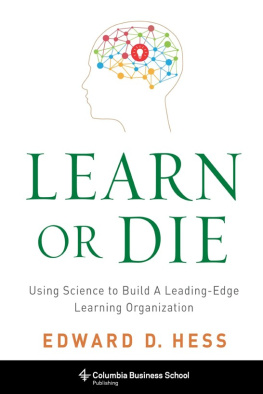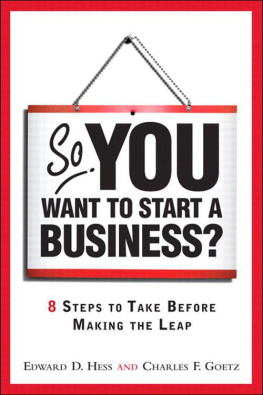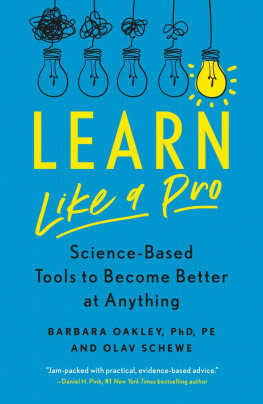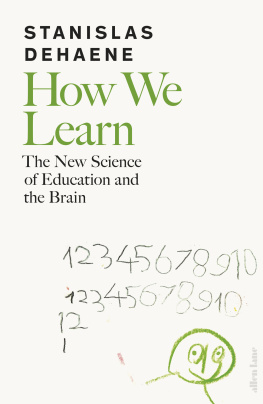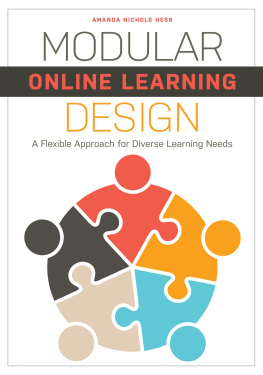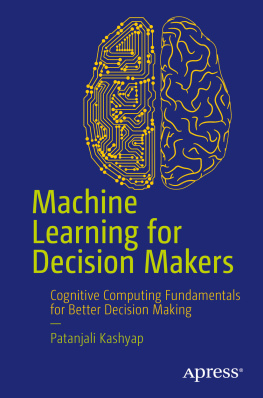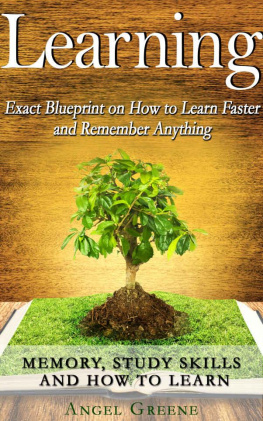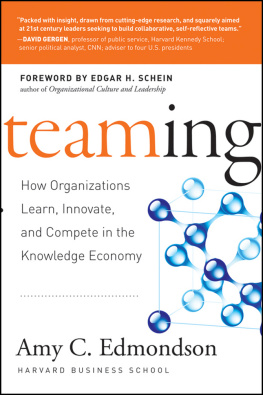
LEARN OR DIE

LEARN OR DIE
Using Science to Build a Leading-Edge Learning Organization
EDWARD D. HESS
 | Columbia Business School Publishing |

Columbia University Press
Publishers Since 1893
New York Chichester, West Sussex
cup.columbia.edu
Copyright 2014 Itzy
E-ISBN 978-0-231-53827-5
Library of Congress Cataloging-in-Publication Data
Hess, Edward D.
Learn or die : using science to build a leading-edge learning organization / Edward D. Hess.
pages cm
Includes bibliographical references and index.
ISBN 978-0-231-17024-6 (cloth : alk. paper) ISBN 978-0-231-53827-5 (ebook)
1. Organizational learning. 2. Organizational effectiveness. I. Title.
HD58.82.H365 2013
658.3'124dc23
2014013370
A Columbia University Press E-book.
CUP would be pleased to hear about your reading experience with this e-book at .
Cover design: Noah Arlow
Cover image: Getty Images
References to websites (URLs) were accurate at the time of writing. Neither the author nor Columbia University Press is responsible for URLs that may have expired or changed since the manuscript was prepared.
To Dr. Lyle E. Bourne, Jr. for elevating my passion for cognitive psychology and for thirty-four years of mentorship, caring friendship, and being an inspiring role model .
CONTENTS
No one publishes a book without lots of help along the way. Let me give thanks.
First, to my parents, Jack and Anita Hess, who gave me the gift of self-efficacy and a love of learning that defined my life.
To my wife, Katherine, who lovingly and unselfishly has always encouraged me to go for it even when my doing so disrupted her life.
To my mentorsCoach Charlie Grisham; Professors Charlie Davison, Lyle Bourne, Jr., and Robert Drazin; Judge Harry Michael, Jr.; and Jack McGovern, Peter Norton, Ira Wender, David Bonderman, Tom Aiello, Dick Waite, and Dr. M. ONeilfor expanding my horizons.
To Dean Tom Robertson and Professors Al Hartgraves, Robert Drazin, L.G. Thomas, and Robert Kazanjian of the Goizueta Business School for giving me the opportunity to enter academia and for supporting my research and writing.
To Jimmy Blanchard, Gardiner Garrard III, Bill Turner, Tom Cousins, and Billy Wren for supporting our Values-Based Leadership Institute at Goizueta Business School.
To Kim Cameron of the Ross School of Business at the University of Michigan whose scholarship and friendship has had an immeasurable positive influence on me.
To Dean Bob Bruner, Jim Freeland, Jeanne Liedtka, and Sean Carr for giving me the opportunity to be part of the Darden Business School at the University of Virginia and to the Batten Institute for funding my research activities for over seven years. To the collegial Darden Faculty who have made me feel at home.
To my research associate, Katherine Ludwig, whose professionalism, high standards, intellectual integrity, research skills, and growth mindset have contributed immensely to this book, making it a great learning experience.
To Myles C. Thompson, publisher at Columbia Business School Publishing and Economics, for his belief in this work and in me.
To Bridget Flannery-McCoy, editor at Columbia University Press, whose consummate professionalism and developmental editing made this a better book for our readers.
To the CEOs of all the organizations, too numerous to name, who have given me the opportunity to research their organizations and learn.
To Kaaren Hanson of Intuit, Rich Buckingham of W.L. Gore & Associates, and Dr. Gary Klein for your generosity of spirit and time, making it possible for me to bring your wonderful stories to our readers.
To Ray Dalio of Bridgewater Associates LP, a learning organization visionary and a learning leader who walks the talk, for the opportunity to both learn about and tell the Bridgewater story with such radical transparency.
To Drs. Katherine L. Acuff, Rita Yaroush, and Lyle Bourne, Jr. for their very helpful critique of chapters of this book.
To three special friends who for decades have always been supportive of my learning forays both good and not so good: Joe Street, Lyle Bourne, Jr., and Terry Brown. Love you, guys!
To my two sparkling granddaughters, Sarah and Caroline, for the reminder that learning can be joyful and for not letting me forget the learning power of the word: Why. Stay curious, my dears!
Learn or Die : Is this just a snappy title or is it a business truth? My research, teaching, and consulting with private and public companies has led me to believe that now, more than ever, organizations and individuals must either be continuously learning, adapting, and improving, or risk professional obsolescence. Whyand why now?
First, many organizations rely on operational excellencegetting better, faster, and cheaperas the key part of their business models; many also rely on innovation to drive growth. The former requires relentless, constant improvement; the latter requires discovery and experimentation. What is the fundamental process underlying both efforts? It is learning.
Both operational excellence and innovation are dependent on learning.
Second, organizations cannot learn unless the individuals within them learn. Individuals must continuously learn to stay relevant and competitivejobwisein a fast-paced, dynamic, global environment characterized by high levels of uncertainty, ambiguity, and change. This environment requires exploration, invention, experimentation, and adaptation, all of which require learning.
Third, globalization and technology continue to increase the speed and reach of change. Today new competitors can arise almost anywhere in the world and, through technology, can reach your customers from thousands of miles away. Technology, especially SaaS (software as a service), reduces the capital needed to start and build businesses, thereby diminishing another historic barrier to entry. Technology empowers consumers to buywith a few clicksfrom anyone, anywhere. Such developments necessitate faster adaptation, and adaptation requires institutional learning processes such as critical thinking, critical conversations, and experimentation.
Environments of uncertainty, ambiguity, and change require exploration, invention, experimentation, and adaptation, all of which require learning.
This increasing pace of change creates volatility that diminishes the life cycle of most competitive advantages, products, and public companies, as well as the tenures of public company CEOs. As a result, strategy making necessarily becomes more dynamic and distributed. Data-driven decision making becomes necessary to manage risks.
In more volatile environments, organizations need institutionalized learning processes to enable speedier adaptation.
The amount, accessibility, and speedy creation of data require an organization to constantly learn to stay relevant. The more data, the faster knowledge is created, and the more unlikely it is that only one person has the answer. Organizations need processes for collaboration and constructive debate that rise above politics and egos. Thinking better, communicating better, making better decisions, and having a healthy regard for what one doesnt know are essential.
The organizational response to changes requires better and faster learning by more people. The Science of Learning
Next page
